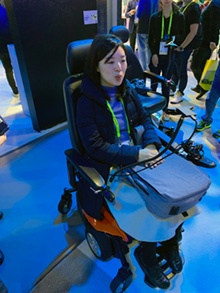People living with higher mobility issues may soon bid farewell to the “puff and suck” power chair controller thanks to the Brazilian tech company, Hoobox One Robotics
By Andy Nemann
A smile is a powerful expression that can brighten anyone’s day, but a Brazilian startup company is giving that facial expression and others even greater power. Hoobox One Robotics, in conjunction with technology giant Intel, debuted the world’s first facially-controlled wheelchair this week in Las Vegas during the massive annual electronics trade show called CES.
The Wheelie 7 uses deep learning abilities to detect and capture different facial expressions that are translated into commands that can then be used to operate any powered wheelchair. A smile, a kiss or a raised eyebrow is all it takes for the device to make a wheelchair move forward, turn, stop or even travel in reverse.
Wheelie 7 creator and Hoobox CEO Paulo Pinheiro, PhD, says the device can be installed on any power wheelchair in only seven minutes. It uses a 3D camera like the ones in the new iPhones to capture a map of your face. That information is sent to an onboard computer, which uses deep learning abilities to recognize and classify the facial expressions you’ve preset to control your wheelchair. Those commands are then sent to a control device that fits over your existing joystick, which then carries out the movement desired.

Using an app on your smartphone or tablet, you choose five of nine available facial expressions to control your chair. The ability of the camera to capture micro-movements on your face and the computer’s deep learning capacity mean it’s able to detect the difference between a smile to make your chair move forward and a smile because someone just told an amusing story. Pinheiro says Wheelie 7 is also able to adapt to the type of facial expressions you can make based on your ability.
“Our team is always trying to develop the classifiers for new facial expressions,” Pinheiro says. “So for a smile, we have a full smile, shy smile and a half smile. So if you can’t make a full smile, you can just give off a half smile on the side of your mouth, and we can use that facial expression to control something on the wheelchair.”
Being displayed as part of Intel’s huge pavilion at CES, the Wheelie 7 had plenty of the trade show’s 200,000 attendees smiling, kissing and winking to test out the chair. While those folks only spent a few minutes with Wheelie 7, United States Quad Rugby Association President Eric Ingram has been working with Pinheiro and Intel for a bit longer to put the device through its paces.
Ingram has only had from two to three total hours of time with Wheelie 7, but he’s used it enough to understand that the technology will be a real game-changer for many people.
“I haven’t had a ton of time to use and it was a little awkward at first, but the more you use it, the more natural it feels and the more intuitive it feels,” Ingram says. “I think it works fairly well. It’s going to be some groundbreaking technology once it reaches the mass market level of production.”
Although it’s only a prototype right now, Pinheiro says the public can purchase the Wheelie 7 and help Hoobox develop it further. He says the final version of the device should be ready to go by the end of the year.
For more information, visit hoobox.one.



